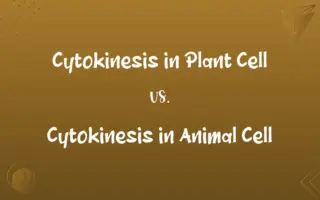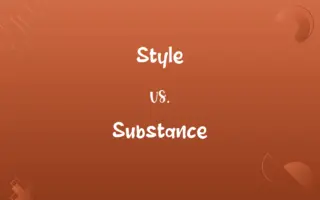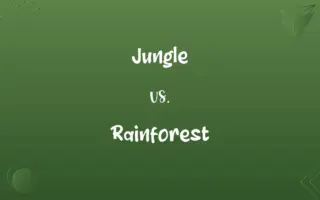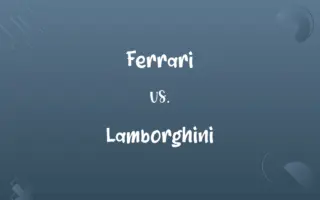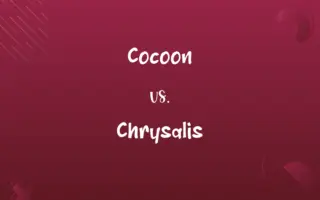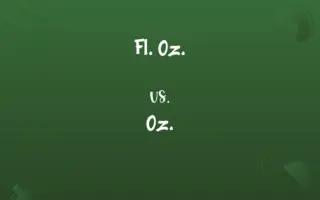C3 Plants vs. C4 Plants: Know the Difference

By Shumaila Saeed || Updated on December 25, 2023
C3 plants use a direct carbon fixation process, common in cooler climates, while C4 plants have a specialized mechanism, efficient in high light and temperature.
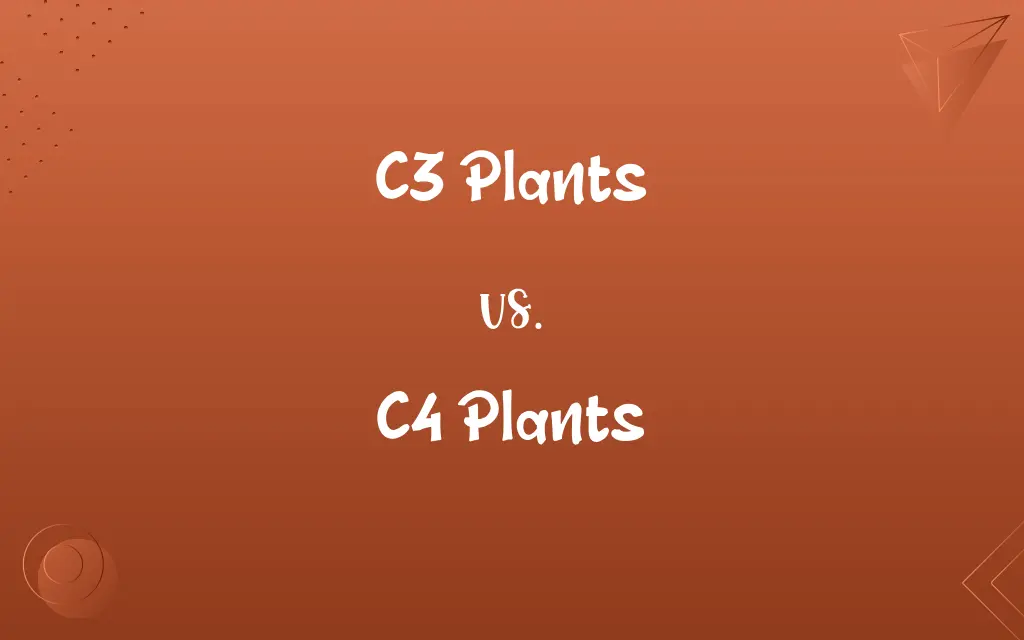
Key Differences
C3 plants follow the Calvin cycle for carbon fixation, directly converting CO2 into a 3-carbon compound. C4 plants, on the other hand, initially fix CO2 into a 4-carbon compound, then transfer it to specialized cells where the Calvin cycle occurs.
Shumaila Saeed
Dec 09, 2023
C3 plants are more efficient under moderate light and temperature conditions and higher CO2 concentrations. C4 plants excel in high-light intensity, high temperatures, and low CO2 conditions, showing less photorespiration.
Shumaila Saeed
Dec 09, 2023
C3 plants have lower water-use efficiency, making them more common in cool, wet environments. C4 plants are more water-efficient, thriving in hot, dry conditions due to their reduced photorespiration.
Shumaila Saeed
Dec 09, 2023
The leaf anatomy of C3 plants is less specialized, with uniform mesophyll cells. C4 plants have a distinct Kranz anatomy, with bundle sheath cells surrounding the vascular bundles, aiding in their unique photosynthetic process.
Shumaila Saeed
Dec 09, 2023
C3 plants are widespread in temperate regions, while C4 plants are predominantly found in tropical and subtropical regions, often dominating grasslands and savannas.
Shumaila Saeed
Dec 09, 2023
ADVERTISEMENT
Comparison Chart
Photosynthesis Process
Direct CO2 fixation in Calvin cycle.
Initial CO2 fixation into a 4-carbon compound.
Shumaila Saeed
Dec 09, 2023
Efficiency Conditions
More efficient in cooler, moderate light.
Efficient in high light, temperature, low CO2.
Shumaila Saeed
Dec 09, 2023
Water Use Efficiency
Lower, suitable for cool, wet areas.
Higher, adapted to hot, dry climates.
Shumaila Saeed
Dec 09, 2023
Leaf Anatomy
Uniform mesophyll cells.
Distinct Kranz anatomy with bundle sheath cells.
Shumaila Saeed
Dec 09, 2023
Geographical Distribution
Common in temperate regions.
Predominant in tropical, subtropical areas.
Shumaila Saeed
Dec 09, 2023
ADVERTISEMENT
C3 Plants and C4 Plants Definitions
C3 Plants
Exhibit lower water-use efficiency.
C3 plants like cotton require more water, making them less suited for arid regions.
Shumaila Saeed
Dec 02, 2023
C4 Plants
Exhibit distinct Kranz leaf anatomy.
Sugarcane, a C4 plant, has the specialized Kranz anatomy in its leaves.
Shumaila Saeed
Dec 02, 2023
C3 Plants
Adapted to moderate light and temperature.
The growth of C3 plants like soybeans is optimal in regions with moderate sunlight.
Shumaila Saeed
Dec 02, 2023
C4 Plants
Thrive in high light and temperature environments.
C4 plants like sorghum are well-adapted to the intense sun of the tropics.
Shumaila Saeed
Dec 02, 2023
C3 Plants
Utilize the Calvin cycle for photosynthesis.
Maple trees, typical C3 plants, undergo photosynthesis via the Calvin cycle.
Shumaila Saeed
Dec 02, 2023
ADVERTISEMENT
C4 Plants
Predominantly found in tropical areas.
The savannas, dominated by C4 plants, support diverse wildlife.
Shumaila Saeed
Dec 02, 2023
C3 Plants
Plants that fix carbon directly into a 3-carbon compound.
Wheat, a C3 plant, thrives in the temperate climate of the Midwest.
Shumaila Saeed
Dec 02, 2023
C4 Plants
More efficient in water usage.
C4 plants, such as Bermuda grass, are ideal for landscaping in arid climates.
Shumaila Saeed
Dec 02, 2023
C3 Plants
Common in temperate climates.
Most deciduous trees are C3 plants, flourishing in cooler, temperate zones.
Shumaila Saeed
Dec 02, 2023
C4 Plants
Plants that initially fix carbon into a 4-carbon compound.
Corn, a C4 plant, efficiently uses CO2 even under high heat.
Shumaila Saeed
Dec 02, 2023
Repeatedly Asked Queries
Are C4 plants common in temperate zones?
They're less common in temperate zones, favoring tropical and subtropical areas.
Shumaila Saeed
Dec 09, 2023
Can C3 plants grow in hot climates?
They can, but are less efficient than C4 plants in hot, dry conditions.
Shumaila Saeed
Dec 09, 2023
What defines C4 plants?
C4 plants have a specialized carbon fixation mechanism, adapting to high light and temperature.
Shumaila Saeed
Dec 09, 2023
Do C4 plants show photorespiration?
They show significantly reduced photorespiration, enhancing efficiency.
Shumaila Saeed
Dec 09, 2023
What are C3 plants?
C3 plants use a direct carbon fixation process in photosynthesis.
Shumaila Saeed
Dec 09, 2023
What's the key anatomical difference in C4 plants?
C4 plants have Kranz anatomy, with distinct bundle sheath cells.
Shumaila Saeed
Dec 09, 2023
How does temperature affect C3 plants?
High temperatures can decrease their photosynthetic efficiency.
Shumaila Saeed
Dec 09, 2023
Why do C3 plants have lower water efficiency?
Due to their direct carbon fixation method and higher rate of photorespiration.
Shumaila Saeed
Dec 09, 2023
What is the Calvin cycle's role in C3 plants?
It's the sole pathway for carbon fixation in C3 plants.
Shumaila Saeed
Dec 09, 2023
Are C4 plants more drought-tolerant?
Generally, yes, due to their higher water-use efficiency.
Shumaila Saeed
Dec 09, 2023
How do urban environments affect these plant types?
Urban heat islands can stress C3 plants more than C4.
Shumaila Saeed
Dec 09, 2023
What role do these plants play in the ecosystem?
They contribute significantly to global carbon fixation and biodiversity.
Shumaila Saeed
Dec 09, 2023
Are all grasses C4 plants?
Not all; many grasses are C3, but many tropical grasses are C4.
Shumaila Saeed
Dec 09, 2023
Can C4 plants survive in low light?
They can survive but are more efficient in high light.
Shumaila Saeed
Dec 09, 2023
Why are C4 plants important in agriculture?
They are crucial for food production in warm, dry climates.
Shumaila Saeed
Dec 09, 2023
Are C4 plants better for biofuel production?
Yes, their efficiency makes them suitable for biofuels like ethanol.
Shumaila Saeed
Dec 09, 2023
Do C3 and C4 plants have different fertilization needs?
Their needs vary based on their environmental adaptations.
Shumaila Saeed
Dec 09, 2023
Can C3 plants be genetically modified to C4?
Research is ongoing, but it's a complex genetic modification.
Shumaila Saeed
Dec 09, 2023
Can C3 plants adapt to high CO2 levels?
They benefit from high CO2, showing increased photosynthesis.
Shumaila Saeed
Dec 09, 2023
Share this page
Link for your blog / website
HTML
Link to share via messenger
About Author
Written by
Shumaila SaeedShumaila Saeed, an expert content creator with 6 years of experience, specializes in distilling complex topics into easily digestible comparisons, shining a light on the nuances that both inform and educate readers with clarity and accuracy.









